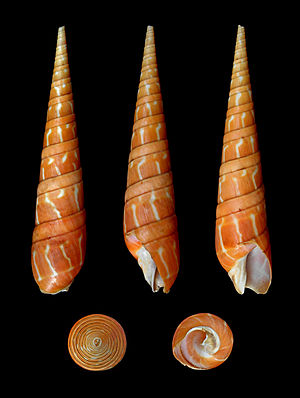Orange screw worm
| Orange screw worm | ||||||||||||
|---|---|---|---|---|---|---|---|---|---|---|---|---|

Housing of Oxymeris dimidiata |
||||||||||||
| Systematics | ||||||||||||
|
||||||||||||
| Scientific name | ||||||||||||
| Oxymeris dimidiata | ||||||||||||
| ( Linnaeus , 1758) |
The orange screw snail ( Oxymeris dimidiata , common synonyms : Terebra dimidiata , Acus dimidiatus ) is a snail from the family of screw snails (genus Oxymeris ) that is common in the western Pacific Ocean . It eats acorn worms , which - unlike most Conoidea - it overwhelms without poison.
features
Oxymeris dimidiata has a very large, firm, pointed snail shell with around 20 rounded whorls and straight sides, which in adult snails is around 8 to 14 cm long and 2.3 cm wide with a shell mouth that is up to 3 cm long. The early whorls have a weak vertical rib and the later have incremental streaks. The case mouth is broadly oval, its outer lip slightly flared at the base. The spindle, which is fairly straight, has a weak fold, and the fasciole is strong. The surface of the shell is smooth and shiny. A slight constriction below the seam divides each passage into a narrow upper third and lower two thirds. The color of the housing is orange-red with wavy white stripes, which often fork into two at the tip.
distribution and habitat
Oxymeris dimidiata is distributed in the Indo-Pacific from the Red Sea and the coast of Tanzania , Mozambique and KwaZulu-Natal via Aldabra , Chagos , Mauritius , Madagascar , the Mascarene Islands , Lakshadweep , Andaman and Nicobar Islands as well as the entire Pacific Ocean to Hawaii . It lives in shallow water on sandy surfaces.
Development cycle
Like all screw snails, Oxymeris dimidiata is sexually separated, and the male mates with his penis . The Veliger larvae swim free before they sink and metamorphose into crawling snails .
nutrition
Oxymeris dimidiata has no poisonous apparatus and therefore swallows still living prey, which it sucks in with its pseudoproboscis. It eats sand-dwelling acorn worms such as Ptychodera flava .
Importance to humans
Oxymeris dimidiata is collected in many areas for its meat and shell, which is used as a tool in some areas of the South Pacific.
literature
- R. Venkitesan, AK Mukherjee (2012): Contribution to the knowledge on Indian marine molluscs: Family Terebridae. Records of the Zoological Survey of India 111 (3), pp. 49-77, here pp. 64f.
- George Washington Tryon: Manual of Conchology, structural and systematic, with illustrations of the species , vol. VII; Academy of Natural Sciences, Philadelphia 1885. T [erebra] dimidiata Linn., P. 9.
- Jerry G. Walls: Cone Shells: A Synopsis of the Living Terebridae TFH Publications, Neptune (New Jersey) 1979. pp. 86-88.
Web links
- Underwater Kwajalein: Oxymeris dimidiata (Linnaeus, 1758)
- Fischhaus Zepkow: Family Terebridae - screw snails
Individual evidence
- ↑ Mande Holford, Nicolas Puillandre, Yves Terryn, Corinne Cruaud, Baldomero Olivera, Philippe Bouchet (2009): Evolution of the Toxoglossa Venom Apparatus as Inferred by Molecular Phylogeny of the Terebridae. Molecular Biology and Evolution 26 (1), pp. 15-25, here pp. 15, 22.
- ↑ John D. Taylor (1986): Diets of sand-living predatory gastropods at Piti Bay, Guam. Asian Marine Biology 3, pp. 47-58.